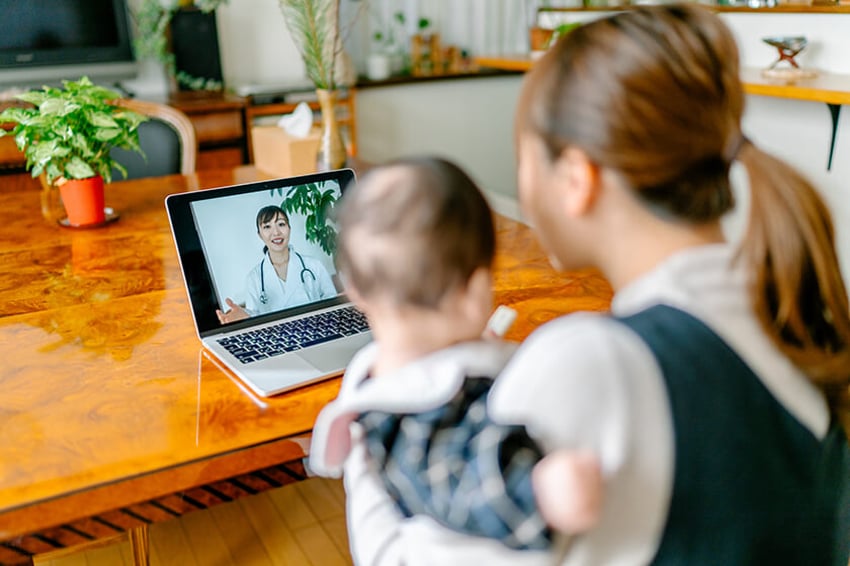The Future of Video Communication: 5 Trends for 2021
Video chat played a big role in how consumers experienced daily life during the COVID-19 pandemic. Here's what video trends we can expect to continue in 2021.

COVID-19 radically disrupted everyday life in 2020, almost instantly transforming the way we work, learn, shop, bank, and receive healthcare. Video communication helped shape the "new normal" for people around the world, keeping them connected and having meaningful interactions with businesses. But what does the future of video look like in 2021? Recent findings from the Vonage Global Customer Engagement Report can give us a clue.
Video Communication Exploded in 2020
Before the pandemic, Vonage research consistently showed that customers already favored video for interactions in which they wanted a personalized experience or situations in which they had a complex problem to resolve. Then, video chat among consumers exploded, as in-person interactions were suddenly restricted and it became clear that voice and text weren't always ideal for certain conversations.
As a result, the U.S. experienced an astonishing four years of growth in video chatting in only seven months, from January to August 2020. Forty-three percent of Americans are now regularly video chatting with businesses, up from 28 percent in January 2020. More people than ever now say video chat is their favorite channel for connecting with businesses—a 140-percent increase over that same period.
5 Video Communication Trends for 2021
The pandemic didn't impact all industries in the same way, however. Travel and leisure ground to a halt as the coronavirus spread across the globe, while telehealth and remote learning emerged as safe alternatives for healthcare and education during the public health crisis.
Here's a look at which industries benefited most from video advancements in 2020, how customer behaviors adapted during this time, and what lasting changes we should expect to see in 2021.
1. Retailers Will Offer Sophisticated Ecommerce Experiences
Consumers demonstrated a growing preference for video chat when shopping online throughout 2020. In January, five percent indicated video was their preferred channel for receiving and replying to order updates and tracking deliveries. By August, that figure doubled to 10 percent. Likewise, in January, six percent of consumers preferred to hop on a video chat when asking simple questions, such as store locations, or completing basic tasks like reordering or returning an item. By August, a full 10 percent leaned toward video communication for these interactions.
As we look toward 2021, the trend toward online shopping experiences—including those facilitated by video interactions—will likely accelerate. Retailers whose businesses were focused on brick-and-mortar sales had to quickly adapt to drastic changes wrought by the pandemic, whereas companies that already had strong ecommerce presences were able to navigate the disruption with greater agility. One clear trend we can expect to see is the unification of offline and online shopping experiences, and video will no doubt be a key part of making that possible.
2. Distance Learning Will Play an Important Role in Education
Distance learning took off in a big way in 2020, as students began receiving online instruction during the pandemic. Whereas 35 percent of learners opted for video when engaging with other students and teachers in a virtual classroom in January, 42 percent of them picked video for the same purpose in August. Students also found video useful for getting fast answers to simple questions—eight percent preferred video for these exchanges in January, while 17 percent did by August.
As 2021 dawns, distance learning will still play an important role in safely supporting access to education across the globe. Live video adoption has been instrumental in enabling this transition, opening the door to digital tutoring for enterprising instructors and helping educators maintain continuity in education with virtual classes. While significant work must be done to make online instruction fully accessible to learners of all abilities, we can expect remote learning to remain central to education in the new year and beyond.
 ÉTUDE MONDIALE
ÉTUDE MONDIALE
3. Telehealth Will Become a Cornerstone of Healthcare
Consumers increasingly used telehealth services throughout 2020, as they sought safe channels for receiving mental health and medical care. Eighteen percent of patients used video to speak with a therapist during a counseling session in January; that figure ticked up to 25 percent in August. Thirteen percent of patients used video communication to describe their symptoms about a non-emergency condition to be matched to the correct service in January; by August, 16 percent chose video.
Prior to the pandemic, telehealth showed considerable promise but hadn't been adopted on such a wide scale. With organizations like the American Psychiatric Association promoting a long-term loosening of telemedicine regulations, we can expect telehealth to become a lasting and more prevalent aspect of healthcare service delivery as we move into 2021. Even after the pandemic ends, patients and service providers alike will likely connect via video APIs and other forms of digital communication in far greater numbers than they did before the pandemic.
4. Digital Banking and Financial Services Will Become the Norm
Video also proved to be a valuable channel for consumers interacting with banking, finance, and insurance companies in 2020. In January, nine percent of consumers selected video when they needed to get step-by-step advice about a banking service; by August, that figure stood at 16 percent. Five percent of them used video when looking for answers to basic questions in January, while nine percent of them did in August.
What can these trends tell us about what to expect in 2021? The banking industry was already in the midst of massive digital transformation before the pandemic hit, adapting to the changing tastes of millennial and Generation Z consumers. As banks struggle to avoid closures and reconfigure their branches to provide personalized experiences, video and other digital channels will play an even more prominent role in serving customers.
5. Remote Work Collaboration Is Here to Stay
Remote work solidified into a norm for knowledge workers in 2020. According to Gartner, 88 percent of organizations encouraged or required their employees to work from home during the pandemic. As they realized the productivity benefits associated with remote work, businesses even began to reevaluate the necessity of leasing large office spaces.
In the new year, remote work will remain part and parcel of how business gets done at many organizations across industries—and video will be a key channel for collaboration across teams. While businesses will have to adjust their remote work processes to avoid employee burnout, video collaboration will be key to business continuity and agility long after the pandemic ends.
Video Communication and the Next Normal
The COVID-19 pandemic created a "new normal" when it came to how we conduct much of our daily lives, from collaborating with colleagues to seeing the doctor. As we welcome the promise of a new year and take steps toward a "next normal," video will be an essential channel for engaging consumers and colleagues across multiple industries, from healthcare to education and beyond.